Could the ‘City of Lost Wages’ persevere with half-full casinos? Las Vegas ponders its coronavirus future
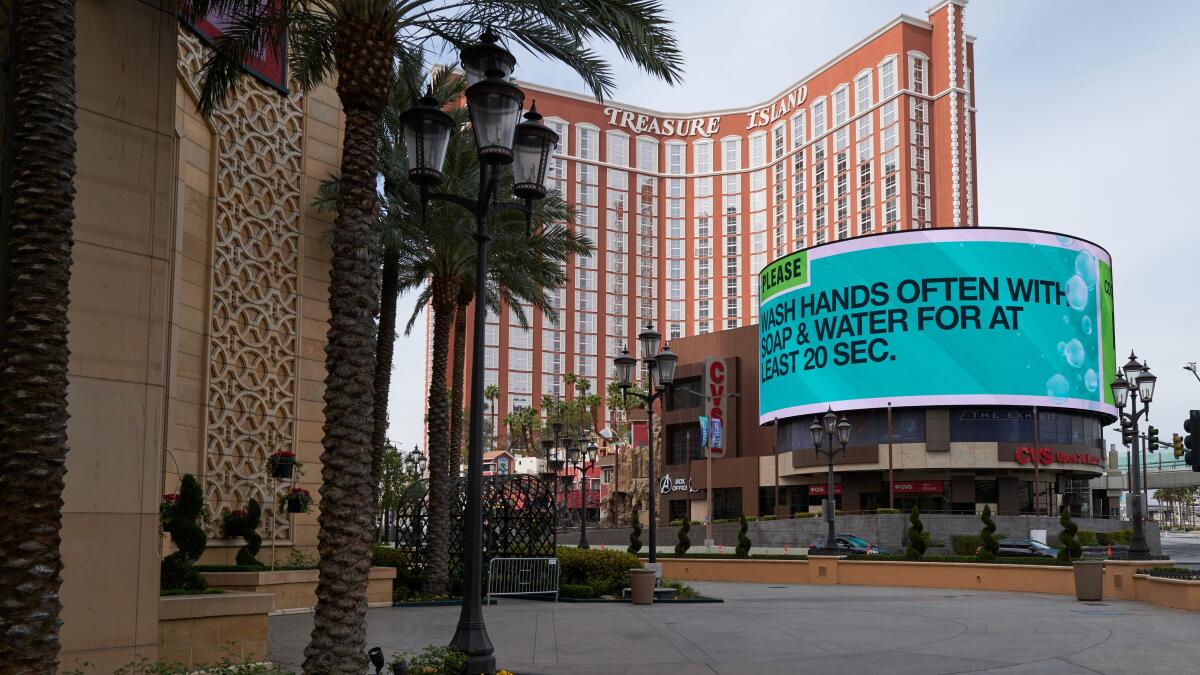
- Share via
LAS VEGAS — Security guards pace aimlessly and cyclists pedal silently along thoroughfares once teeming with tourists and showgirls. Janitors — wearing face masks and gloves — spray disinfectant on infrequently touched handrails, door knobs and staircases along the eerily silent Strip. In the desert heat, neon lights outside empty casinos display messages urging people to stay away.
More than seven weeks after Nevada Gov. Steve Sisolak’s stay-at-home orders were put in place to slow the spread of the deadly coronavirus, the bustling heart of Las Vegas remains one of the bleakest faces of the nation’s pandemic-driven crisis.
About 1.5 million people visited Las Vegas in March 2020 — the month the crisis began — compared with the more than 3.6 million tourists who visited the same time last year, according to the Las Vegas Convention and Visitors Authority.
With the closure in mid-March of casinos, hotels, shows and restaurants, joblessness in southern Nevada’s leisure and hospitality sector — which accounts for 30% of the work force — has skyrocketed.
Nearly 419,000 Nevadans have filed for unemployment claims since early March, according to the U.S. Department of Labor. Roughly 40% were from food and service industry workers, most of whom work in southern Nevada, said Stephen Miller, director for the Center of Business and Economic research at the University of Nevada, Las Vegas.
With no vaccine in sight, the city’s business model — luring throngs of carefree tourists packed inside sweaty nightclubs and shows or pressing the buttons on frequently touched slot machines — seems particularly fraught.
Sisolak, a Democrat, said that as of Saturday, hair salons, restaurants, outdoor malls, retail stores and barbershops could reopen under strict social-distancing requirements. Such businesses must limit customers to no more than 50% of the occupancy limit and require employees and customers to wear face masks and stand six feet apart.
But the heart of Vegas — gaming operations, nightclubs, bars, shows and strip clubs — will remain shuttered through at least May 30.
The governor’s directive followed a 14-day downward trajectory of coronavirus cases and COVID-19-related hospitalizations in the state.
But “we are not done with this fight,” Sisolak said. “The coronavirus is still with us and as strong as ever. If we want to stay open, it’s on us to continue social-distancing measures.”
No date has yet been set by the Nevada Gaming Control Board for the reopening of casinos, but guidelines were approved Thursday: Once resorts and hotels on the Strip begin to reopen, the number of visitors allowed inside would be cut in half, nightclubs would remain closed until further notice, and fewer slot machines would operate. Hand sanitizing stations would be ubiquitous, and guests would be told to wear face masks, continue social distancing and not huddle in groups around gaming tables.
As well, restaurants and bars would have reduced seating and employees would be required to frequently disinfect high-touch surfaces, such as ATM machines, casino cage counters, gaming tables and restaurant menus.
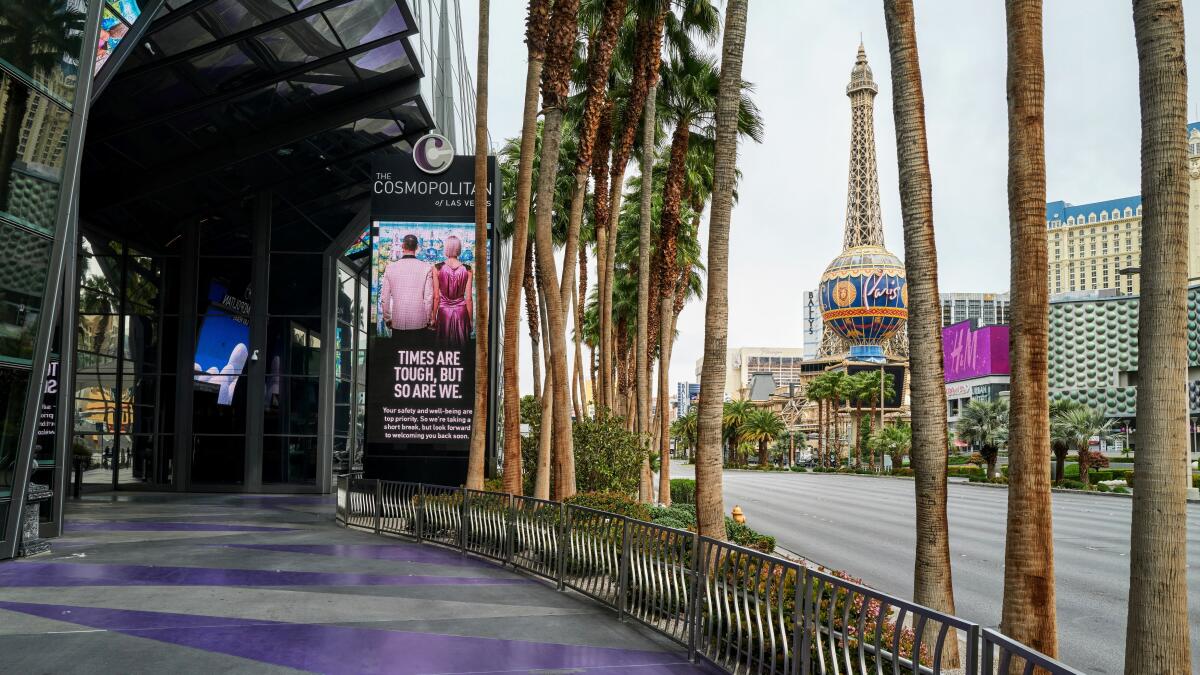
Before the outbreak, the unemployment rate here was among the lowest in the country, and nearly $27 billion worth of development projects were in the pipeline across the state.
Now, some who work on the Strip say they can’t afford to wait to see whether they’ll get their jobs back.
Nicolette Pantaleo worked as a party pit dancer at the Flamingo Hotel and Casino for two years before being laid off March 13. The 29-year-old Nevada native said she’s taking online financial classes and voice-over lessons with the hopes of landing a job as an investment banker or narration artist.
“I have no desire to dance anymore,” she said. “I had a lot of success as a professional dancer in Vegas over the last 11 years. I’ll cherish that memory. But I don’t know whether I still have a future here.”
Others who’ve been laid off said they have been so busy fighting to get unemployment benefits that they haven’t had the time to focus on the future.
“I haven’t received any money since mid-March. I go to bed thinking about it and wake up thinking about it,” said Keith Wade, 62, a furloughed baccarat dealer at a casino-hotel on the Strip. “And I feel like I’m lucky compared to others. I have already paid off my home and was planning on retiring in a few years. I know people who’ve had to cut back on groceries and watch what they’re spending.”
With 42 million visitors each year, tourism generates $58 billion annually, according to the Las Vegas Convention and Visitors Authority. Gambling revenue from casinos operating inside resorts and large hotels on the Strip alone amounts to $6.6 billion each year.
“Las Vegas is more dependent on tourism than Detroit is on auto manufacturing,” said Jeremy Aguero, an analyst at the Las Vegas-based research firm Applied Analysis.
Even so, county officials and experts say they do not expect casinos and hotels to all open at once.
“It’s not as if the moment the governor says ‘go’ that millions of people will be flocking to the Strip,” Clark County commissioner Justin Jones said. “It’s likely that MGM and Caesars Entertainment, which own multiple properties on the Strip, will start by opening up a few hotels and casinos and seeing how it goes.”
UNLV’s Miller predicts “recovering from this [crisis] will likely take longer and be a slower process in Las Vegas than the rest of the United States,” because people need to feel comfortable traveling again and feel safe once they arrive.
Wynn Resorts announced Wednesday that it would continue to pay all salaried, hourly and part-time employees through May 31. And Las Vegas Sands, which owns the Venetian and Palazzo, announced April 23 that it would continue paying employees until at least May 17. MGM Resorts and Caesars Entertainment, which operates 10 hotels along or near Las Vegas Boulevard, paid workers only for the first two weeks of the shutdown.
These days, some Las Vegas natives find themselves embracing the slower pace, to a point.
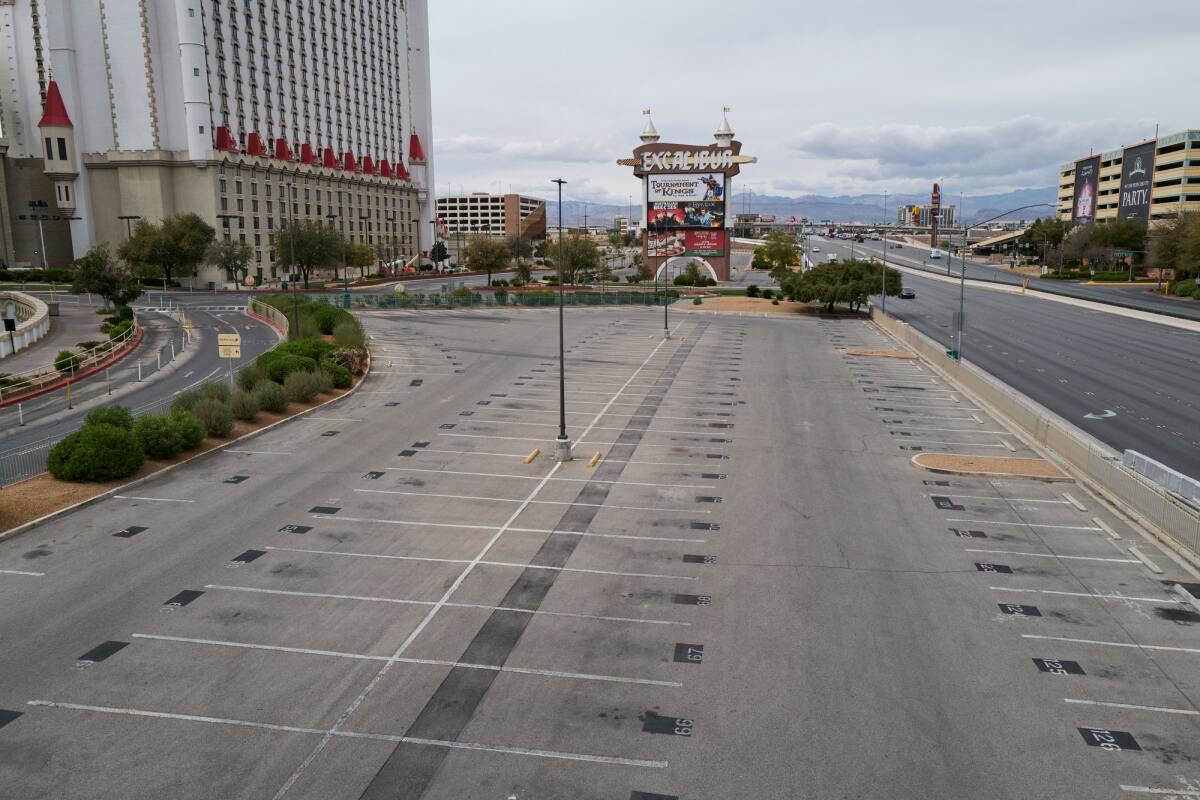
A few weeks ago, Jacqueline Shukes, who was laid off from her job as a visual merchandise employee at Forever 21, took a stroll down the Strip for the first time in five years. Like other locals, Shukes had typically avoided loud and chaotic areas that were crowded with rowdy tourists. Although she’s enjoyed reclaiming that space, she’s realized as the weeks have dragged on just how much she misses the tourists.
“I’ve noticed things that I didn’t see before, like the details on casinos and architecture on the hotels,” said Shukes, 23, as she posed with friends under the iconic “Welcome to Fabulous Las Vegas” sign one recent afternoon. “It’s lonely though and makes me sad.”
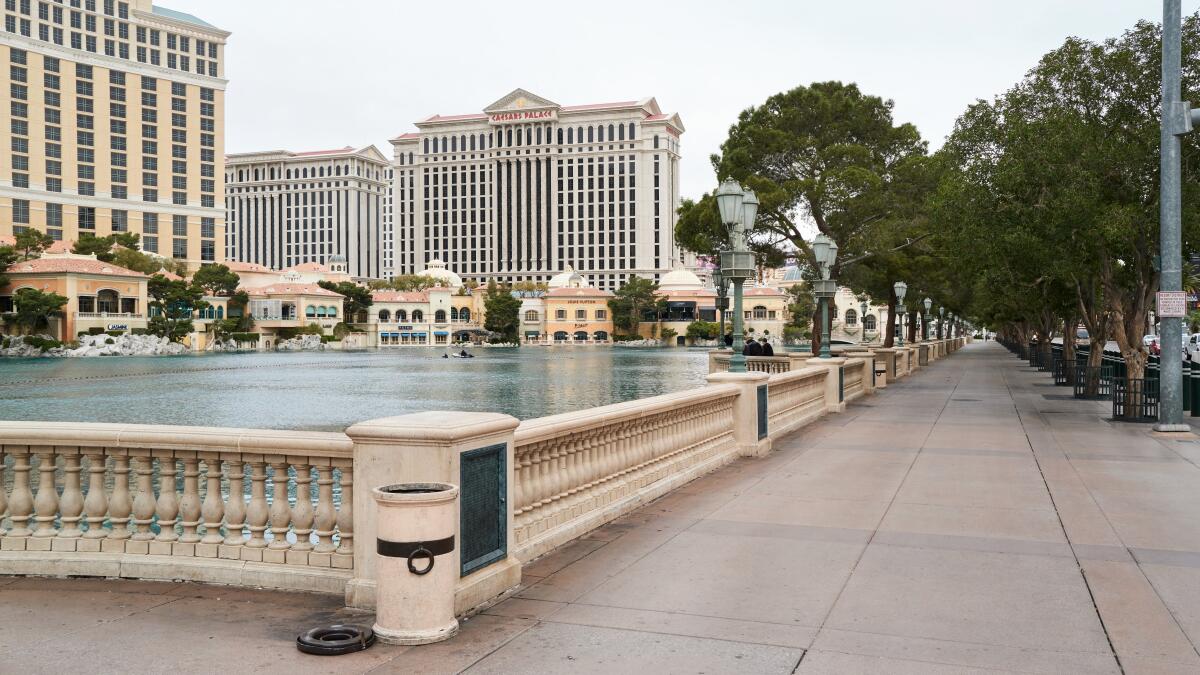
Down the strip at the Bellagio, Luke Weyan posed in front of the now-silent fountains with his fiancee as a friend snapped photographs.
“When is it ever going to be this empty again? Probably never,” said the 21-year-old UNLV senior.
Those who’ve spent most of their careers working in Las Vegas’ gaming industry are used to rowdy clubgoers and throngs of gamblers as part of daily life. James Adkins, a casino floor supervisor who said he was not authorized to disclose the name of the business where he works, finds himself pleasantly surprised with just how well he’s adapting.
“I don’t dislike my job, but I’ve been happy to enjoy this time off,” said Adkins, who now spends his days helping take care of his 3-year-old son while his wife works from home.
Still, he misses his co-workers. “I started a Facebook group and invited a lot of co-workers, and that’s helped us stay in touch and remember that we’re all in this together,” he said.
Adkins acknowledges that one reason he’s been able to relax is because the property he works for is still paying him. And because he was a full-time employee with seniority, he is confident he’ll be able to get his job back.
“I’m very blessed,” Adkins said. “The thing that worries me is how slow it will be for a while... I worry for those that won’t be working if it’s slow.”
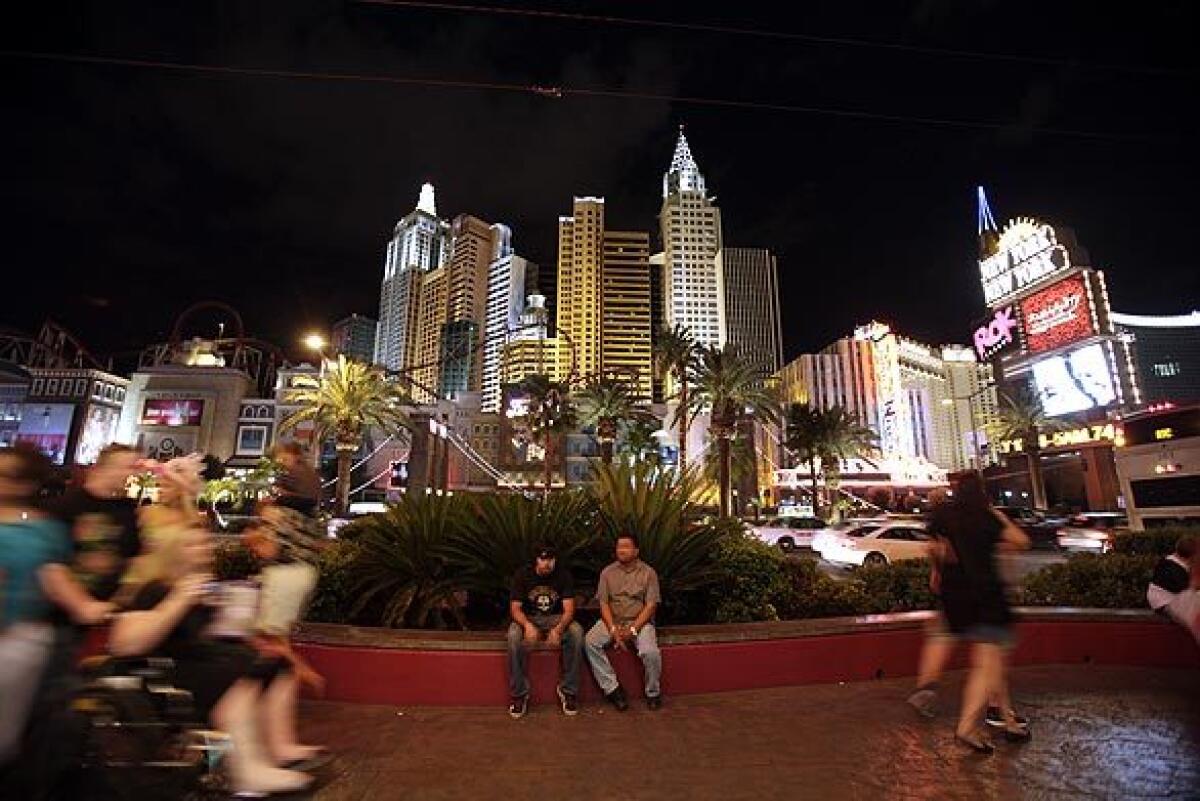
Locals often say that Las Vegas is only as successful as its ability to reinvent itself. From the Great Recession in 2008 to the 2017 mass shooting at the Route 91 Harvest Festival, Sin City has overcome adversity.
How it will re-create its image now is a question public officials and experts have been pondering.
“This crisis has been about ingenuity and creativity,” said Aguero, the analyst. “We try to use our creativity in terms of figuring out how to get people to stay home. How to keep people safe. Now we have to use that ingenuity to get people back to work.”
More to Read
Sign up for Essential California
The most important California stories and recommendations in your inbox every morning.
You may occasionally receive promotional content from the Los Angeles Times.










